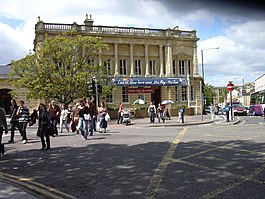Bath Green Park railway station
| Bath Green Park | |
|---|---|

Bath Green Park station from James Street West
|
|
| Location | |
| Place | Bath |
| Area | Bath and North East Somerset |
| Coordinates | 51°22′53″N 2°22′01″W / 51.3815°N 2.367°WCoordinates: 51°22′53″N 2°22′01″W / 51.3815°N 2.367°W |
| Grid reference | ST745647 |
| Operations | |
| Original company | Midland Railway |
| Pre-grouping | Midland Railway |
| Post-grouping | London, Midland and Scottish Railway |
| Platforms | 2 |
| History | |
| 7 May 1870 | Station opened as Bath |
| 18 June 1951 | Renamed Bath Green Park |
| 7 March 1966 | Station closed |
| Disused railway stations in the United Kingdom | |
| Closed railway stations in Britain A B C D–F G H–J K–L M–O P–R S T–V W–Z |
|
|
|
|
Green Park railway station is a former railway station in Bath, Somerset, England. For some of its life, it was known as Bath Queen Square.
Green Park station was opened in 1870 as the terminus of Midland Railway's Mangotsfield and Bath Branch Line. The station buildings were designed by the Midland Railway architect John Holloway Sanders.
Originally named Queen Square station, it was built in an elegant style which blends well with the Georgian buildings around it and includes a vaulted glass roof in a single-span wrought iron arch structure.
The platform accommodation in the station was modest, having an arrival platform and a departure platform, with two sidings between them. The siding adjacent to the arrival platform was equipped with ground frame points to release an arriving train engine.
The station is on the north bank of the River Avon. The locomotive shed was about half a mile from the station to the north side of the main tracks. The goods yard was on the opposite side of the tracks from this.
The Midland Railway's Bath branch had opened in 1869, but the river Avon bridge and the new station were not ready, so for a year the terminus was at a temporary station to the west of the river.
Immediately outside the station, trains crossed a bridge over the Avon. This bridge is a Town truss, a design patented by the American architect Ithiel Town in 1820 with the aim of reducing the labour costs in constructing timber bridges. From the late 1840s the design was adapted in Britain for construction in wrought iron, and the Avon Bridge is a fine surviving example. Since closure of the railway, the bridge has been adapted to provide vehicular and pedestrian access to Sainsbury's supermarket.
When the Somerset and Dorset Railway completed its Bath extension line in 1874, they connected into the Midland line at Bath Junction via the newly constructed Midland Bridge, a half mile outside the station, and in friendly co-operation with the Midland company they used the station. This created considerable additional through traffic, and as well as heavy volumes of freight, through passenger journeys from the Midlands to the South Coast were created. Through trains had to reverse at Bath, and the most famous of these was the named Pines Express from Manchester (and at times other northern originating points) to Bournemouth West.
...
Wikipedia
